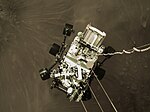astro.wikisort.org - Star
V723 Monocerotis is a variable star in the constellation Monoceros. It was proposed in 2021 to be a binary system including a lower mass gap black hole candidate nicknamed "The Unicorn".[1] Located 1,500 light years from Earth, it would be the closest black hole to our planet, and among the smallest ever found.[8][9]
| Observation data Epoch J2000.0 Equinox J2000.0 | |
|---|---|
| Constellation | Monoceros |
| Right ascension | 06h 29m 04.659s[2] |
| Declination | −05° 34′ 20.23″[2] |
| Apparent magnitude (V) | 8.21 - 8.42[3] |
| Characteristics | |
| Spectral type | G0II[4] |
| Variable type | Ellipsoidal[5] |
| Astrometry | |
| Proper motion (μ) | RA: −1.347 mas/yr[2] Dec.: 16.140 mas/yr[2] |
| Parallax (π) | 2.1748 ± 0.0331 mas[2] |
| Distance | 1,500 ± 20 ly (460 ± 7 pc) |
| Absolute magnitude (MV) | +0.93[6] |
| Orbit[1] | |
| Period (P) | 59.9398 d |
| Eccentricity (e) | 0 (fixed) |
| Inclination (i) | 87.0+1.7 −1.4° |
| Argument of periastron (ω) (secondary) | 0 (fixed)° |
| Details | |
| Giant star | |
| Mass | 0.44±0.06[5] M☉ |
| Radius | 22.5±1.0[5] R☉ |
| Luminosity | 173±8[1] L☉ |
| Surface gravity (log g) | 1.7±0.1[1] cgs |
| Temperature | 3,800±100[5] K |
| Metallicity [Fe/H] | −0.9±0.1[1] dex |
| Rotational velocity (v sin i) | 15±2[5] km/s |
| Age | 5.4+5.1 −2.6[1] Gyr |
| Stripped subgiant | |
| Mass | 2.8±0.3[5] M☉ |
| Radius | 8.3±0.4[5] R☉ |
| Temperature | 5,800±200[5] K |
| Rotational velocity (v sin i) | 70±10[5] km/s |
| Other designations | |
| Database references | |
| SIMBAD | data |
Located in the Monoceros constellation, V723 Monocerotis is an eighth-magnitude ellipsoidal variable yellow giant star roughly the mass of the Sun, but 25 times its radius. The accompanying black hole was proposed to have a mass 3 times the mass of the Sun, corresponding to a Schwarzschild radius of 9 kilometers.[10][11]
Follow-up work in 2022 argued that V723 Monocerotis does not contain a black hole, but is a mass-transfer binary containing a red giant and a subgiant star that has been stripped of much of its mass.[5]
See also
- Stellar black hole
- List of nearest known black holes
References
- Jayasinghe, T.; et al. (2021-01-01). "A unicorn in monoceros: The 3 M⊙ dark companion to the bright, nearby red giant V723 Mon is a non-interacting, mass-gap black hole candidate". Monthly Notices of the Royal Astronomical Society. 504 (2): 2577–2602. arXiv:2101.02212. Bibcode:2021MNRAS.504.2577J. doi:10.1093/mnras/stab907.
- Brown, A. G. A.; et al. (Gaia collaboration) (2021). "Gaia Early Data Release 3: Summary of the contents and survey properties". Astronomy & Astrophysics. 649: A1. arXiv:2012.01533. Bibcode:2021A&A...649A...1G. doi:10.1051/0004-6361/202039657. S2CID 227254300. (Erratum: doi:10.1051/0004-6361/202039657e). Gaia EDR3 record for this source at VizieR.
- "V723 Mon". Variable Star Index. Retrieved 2022-03-23.
- Houk, N.; Swift, C. (1999), "Michigan catalogue of two-dimensional spectral types for the HD Stars", Michigan Spectral Survey, 5, Bibcode:1999MSS...C05....0H.
- El-Badry, Kareem; Seeburger, Rhys; Jayasinghe, Tharindu; Rix, Hans-Walter; Almada, Silvia; Conroy, Charlie; Price-Whelan, Adrian M.; Burdge, Kevin (2022). "Unicorns and giraffes in the binary zoo: Stripped giants with subgiant companions". Monthly Notices of the Royal Astronomical Society. 512 (4): 5620–5641. arXiv:2203.06348. Bibcode:2022MNRAS.512.5620E. doi:10.1093/mnras/stac815.
- Strassmeier, K.; Washuettl, A.; Granzer, Th.; Scheck, M.; Weber, M. (2000). "The Vienna-KPNO search for Doppler-imaging candidate stars. I. A catalog of stellar-activity indicators for 1058 late-type Hipparcos stars". Astronomy and Astrophysics Supplement Series. 142 (2): 275. Bibcode:2000A&AS..142..275S. doi:10.1051/aas:2000328.
- "V723 Mon". SIMBAD. Centre de données astronomiques de Strasbourg. Retrieved 2021-11-27.
- "Newfound black hole may be the closest to Earth". Science. 2021-04-29. Retrieved 2021-08-09.
- "A black hole dubbed 'the Unicorn' may be galaxy's smallest one". Reuters. 2021-04-22. Retrieved 2021-08-09.
- "Is the "Unicorn" the Closest Black Hole?". Sky & Telescope. 2021-04-23. Retrieved 2021-08-09.
- "Where is the nearest black hole to Earth?". BBC Sky at Night Magazine. Retrieved 2021-08-09.
Further reading
- Masuda, Kento; Hirano, Teruyuki (April 2021). "Tidal Effects on the Radial Velocities of V723 Mon: Additional Evidence for a Dark 3 M⊙ Companion". The Astrophysical Journal Letters. 910 (2): 10. arXiv:2103.05216. Bibcode:2021ApJ...910L..17M. doi:10.3847/2041-8213/abecdc. S2CID 232168389. L17.
На других языках
[de] V723 Monocerotis
V723 Monocerotis (V723 Mon) ist ein veränderlicher Stern im Sternbild Monoceros (Einhorn). Vermutlich handelt es sich um ein Doppelsternsystem, das ein stellares Schwarzes Loch an der unteren Massegrenze mit inoffizieller Bezeichnung „The Unicorn“ enthält.[1] Mit einer Entfernung von 1.500 Lichtjahren zur Erde ist es möglicherweise das unserem Planeten am nächsten gelegene Schwarze Loch und das kleinste, das jemals gefunden wurde.[2][3]- [en] V723 Monocerotis
Другой контент может иметь иную лицензию. Перед использованием материалов сайта WikiSort.org внимательно изучите правила лицензирования конкретных элементов наполнения сайта.
WikiSort.org - проект по пересортировке и дополнению контента Википедии



